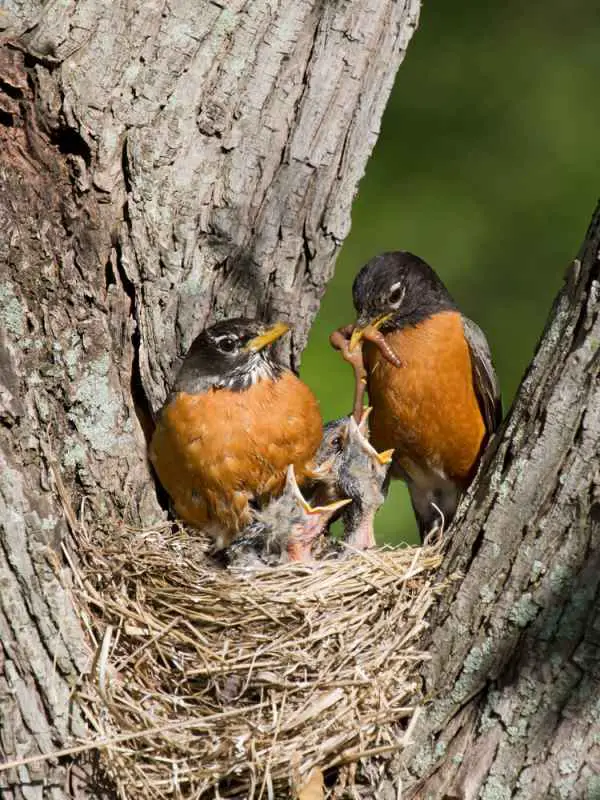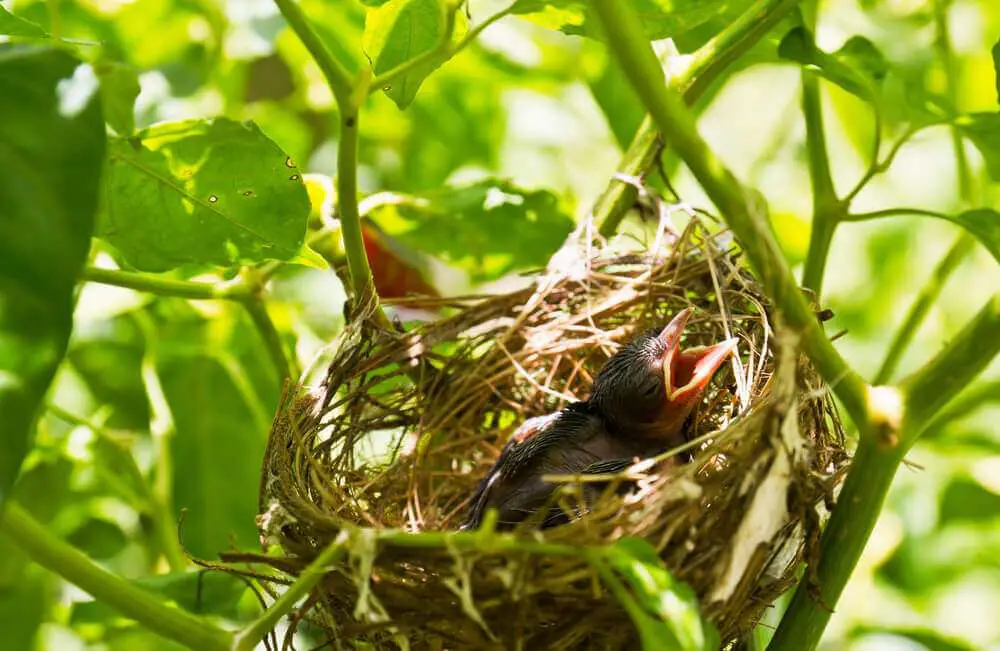Juvenile robins spend about 2 weeks in the nest after they are born, sustained by constant feedings from both parents—up to 100 times per day. When they are ready to fledge, they leave the nest never to return, but where do these adventurous birds travel to when they head out from home?
Young robins are ready to fledge and leave the nest at the age of 2 weeks. Most juvenile robins don’t travel more than a couple of kilometers away from the nest, during which time they may still be fed by their parents and continue to develop their flight over a course of 4-6 weeks.
The journey from the nest is an arduous one for many baby birds, and robins are no exception. The rest of this article will discuss what baby robins do when they leave the nest.
First Flight
When baby robins have fledged and are ready to leave, they flap and flutter their way down to the ground on their developed, yet underused wings. On the ground, robins are at much greater risk of being eaten by predators, so they need to learn to fly quickly.
They do so by running and flapping their wings, thereby building their leg and wing strength. After just a few days of practice, baby robins can take short flights on their own, although attaining full flight usually takes 4-6 weeks.
The challenge of flight for baby robins comes not only from underdeveloped wings, but also from their tail. While juveniles, baby robins have short tails that aren’t much use for balance during flight. As they develop, the tail lengthens and the feathers develop to facilitate flight.
Hiding from Predators
The primary concern for baby robins when they leave their nest is predation. As such, they tend to rely on their natural prey instinct and hide in the grass.
Fledglings hide as much as possible since they have no natural defense against predators. The speckled marks provide some form of camouflage to veil the juveniles in the brush.
Some of the common threats that fledgling robins face include crows, blue jays, snakes, squirrels, cats, and chipmunks. The robins learn to differentiate friend and foe through their natural instincts—the same instincts that prompt them to fly, migrate, and seek food.
Growing in Strength
In order to reach adulthood and survive, baby robins must develop their skills and become strong fliers. The best way to do this, of course, is with practice.
As their flying improves, the dad may take tutelage, along with other dads, of many juvenile robins who are learning to fly. During this time, the robins learn how to cooperate as a flock and will roost alongside others of their kind.
Robins never return to their original nests, but the majority do tend to stick around, usually within a 3-mile radius of the nest. As they stretch their wings, so to speak, baby robins will explore, gaining both physical strength for flight and experiencing the world around them.
Not So Independent

Even after fledging, juveniles are still somewhat dependent on their parents, which is quite the juxtaposition from the common association of “leaving the nest.” The mom will usually leave shortly after the babies have fledged to lay a new clutch of eggs, but both Mom and Dad play a role in feeding the babies for a short time after fledging.
When both Mom and Dad depart to see their next offspring, the baby robins are completely at the mercy of their environment.
Learning the Language
Another important part of the fledging process is learning to communicate. Robins speak using different vocalizations that are designed to share different messages and communicate with other robins. As they grow up, baby robins leaving the nest will learn to imitate and emulate these noises.
Knowing when to speak and when to stay silent is an important survival skill to learn. Robins depend on these vocalizations to warn them of predators, establish territories, and communicate with allies.
Finding Food
Another important coming of age skills that robins need to learn is feeding themselves. Young robins learn to identify the right food by imitation; they watch Dad eating fruit from a tree and, when they recognize that Mom and Dad are no longer going to feed them directly, the juveniles will seek out similar foods for themselves.
Initially, Dad may guide the babies to a cherry tree and feed them. Soon afterwards, the babies learn how to feed from different sources. Robins mainly eat insects, berries, and earthworms.
In the early summer, insects comprise the majority of a robin’s diet, but during the winter, they will consume wild berries and cultivated fruits.
Check out this guide to learn what Robins eat when there is snow on the ground.
Reaching Independence
Just 12-15 days after leaving the nest, fledglings are more capable of caring for themselves and have learned how to fly and feed themselves. At the end of summer, the majority of juvenile robins look much like their parents: full-fledged adults.
Additionally, when summer ends, most young adults will be living alongside and flying with a flock. As they do, they continue to learn from the more mature adults in the flock to understand their place.
In time, when they mature, robins will mate and start their own family to begin the cycle of life anew. Just as their parents did, the female will lay 3-4 and both parents will care for them until they hatch, taking care of the young until they, too, are ready to fledge.
Related Read: Do Robins Reuse Their Nests?
Final Thoughts
The growth from a hungry juvenile to an independent adult is a daunting one, fraught with many perils. Some robins do not survive, but those that do generally live near their parents for a time, learning to feed themselves and building their strength for flight.
Should they survive the dangers in the natural world, the robins will develop their independence over the course of several weeks. Once they reach a year old, robins are capable fliers, sexually mature, and likely part of a flock.


